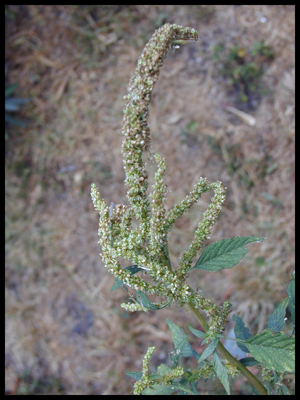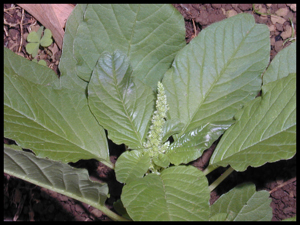
Amaranthus spp. (Pakai)
PLANT NAME: Amaranthus spp.
SIMILARLY USED SPECIES: A. blitus; A. caudatus; A. dubius; A. edulis; A. hibridus; A. hypochondriacus; A. viridus. Please note that for all practical purposes, A. viridus can be used as a substitiute for A. spinosus. A lot easier on the hands, too, as A. viridus has no spines.
COMMON NAMES: Pakai (Amaranthus spp.), pakai kükü (A. spinosus)[Hawai’i]; zhi xian, tz’u hsien-ts’ai, [China]; tanduliyah [India] ban lunde [Nepal]; amaranth, spiny amaranth (A. spinosus), red cockscomb, love-lies-bleeding, pigweed [USA]; chiori con espinas [Bolivia]; khichka jat’aqo [Quechua]; mullu keerai, neer keerai, tanduliuyah [India]; gansam lodut, surindi [Borneo]; ntungu [Tanzania].
NOMENCLATURE: Amaranthus is from the Greek “amarantos” which means “unfading,” a reference to the persisting color of certain amaranth flowers. Or…. the name Amara means “bitter.” Take your pick. Spinosus means “spiny,” as does kükü.
FAMILY: Amaranthaceae.
CATEGORY: Herbs that stop bleeding~.
PROPERTIES: Sweet and bland tasting, astringent, cool
PLANT PART USED: Aerial parts.
TOXICITY: Amaranthus retroflexus (not known to grow in Hawai’i) is reportedly nephrotoxic to large domestic animals [Oladosu 1979], although not to rabbits [Schamber 1985]. In China, the roots are said to be mildly toxic and overdose can cause dizziness, nausea, and vomiting.
CAUTIONS AND CONTRAINDICATIONS: Never treat bleeding without first determining its cause.
Not in menstruation or pregnancy. Caution with osteoporosis or calcium imbalances~ [Larsen 2003]. See Use As Food above. The genus has been reported to cause dermatitis and photosensitivity. The pollen has been reported to cause keratitis of the eye.
PREPARATION OF MEDICINE: Usually decocted or poulticed.
DOSAGE: 10 grams in formula, 30 – 60 grams as a single herb. Up to 300 grams of the fresh root is used in China for duodenal and gastric ulcers. (I would not consider using such a dose).
STATUS IN HAWAI’I: Alien bad boy.
WESTERN FUNCTIONS REPORTED: Antiemetic; anti-inflammatory; astringent; blood purifier; carminative; diaphoretic; diuretic; emmenagogue; emollient; expectorant; febrifuge; galactogogue; hemostatic; improves digestion; lactogogue; laxative; mucilaginous; promotes appetite; purgative; sudorific.
TRADITIONAL CHINESE ENERGETIC FUNCTIONS (~ = extrapolated):
1) Clears heat and poison
2) Improves digestion
3) Stops bleeding
OTHER ENERGETIC FUNCTIONS: Benefits pitta and kapha.
Pakai Common Medicinal Uses
- Excessive menstruation
- GI bleeding
Pakai Cross-Cultural Medicinal Uses
BITES & STINGS
- Insect bites [Philippines (leaves)]; scorpion sting [India (root)]; snakebite (root internal) [Ghana, India, Philippines].
CARDIOVASCULAR
- Mild internal bleeding [China, India].
- Hemophilia [India].
DERMATOLOGICAL
- Topical for eczema (leaves & root) [China, India, Nepal, Philippines]; psoriasis [Philippines (leaves)].
- Rashes [Philippines (leaves)].
- Sunburn [Philippines (leaves)].
- Burns (leaves poulticed) [Nepal, Philippines].
DIGESTIVE
- Enteritis, dysentery [Borneo, China]; mild diarrhea [USA].
- Gastric or duodenal ulcer [China].
- Indigestion [India]; nausea [India].
- Enema [Ghana].
- Hemorrhoids [China, Ghana, India].
HEAD AND THROAT
- Nose bleeds (topical).
- Mouth ulcers (topical).
- Toothache [India (root chewed with salt)].
HEPATIC
- Gall bladder inflammation, gall stones [China].
INFECTION
- Topical for boils, abscesses (leaves or root poulticed) [China, India, Nepal]; foot sores (stem decocted, topical) [India].
- Fever [China, Philippines].
MUSCULOSKELETAL / TRAUMA
- Broken bones (seeds poulticed)
- Bruises [Malaysia (leaves poulticed)]; wounds (topical)
ONCOLOGY
- Tumors (poulticed) [Mauritius, Java, South East Asia].
- Uterine tumor [Cambodia].
PEDIATRIC
- Colic (root) [India, Nepal].
- Laxative for children [Nepal (leaves and roots boiled)].
PSYCHOSPIRITUAL
- The Lodha of West Bengal, India, reportedly make a hallucinogenic smoking powder from the root of A. spinosus. (Sounds like “banana peels”)
- Ceremonial medicine in “Green Corn Medicine” [Cherokee].
REPRODUCTIVE
- Excess menstrual bleeding (leaves, roots) [Cherokee, India, Nepal]; abnormal uterine bleeding.
- Edema during pregnancy [India (young leaves internal)].
- Vaginal discharge (topical),
- Gonorrhea, genital discharge [India, Nepal].
RESPIRATORY
- Cough, coughing up blood [India (seed)],
- Bronchitis [Malaya]; wheezing [Malaya].
URINARY
- Edema (in bath or leaves as a vegetable) [Ghana, India].
- Bladder infections [India].
OTHER MEDICINAL USES
- Burningsensations, “heat in the body” [India (seed)].
- Inflammation [Java].
- “Poisonous affections” [India].
USE AS FOOD: High in protein and calcium. It is used as a food crop by the Aztec Indians of Mexico, as a spinach substitute in Australia, and as a vegetable in China. The seeds can be boiled into a hot cereal. Cook for at least an hour.
The young shoots make a very tasty potherb or in salads. While high in calcium, however, Amaranth that also contains large amounts of oxalates may actually inhibit calcium absorption [Larsen 2003]. Because it may absorb nitrates from the soil and form oxalate crystals in the leaves, only organic pakai should be used [Elpel 2000].
OTHER USES: In Swaziland the ash of whole plant used as a snuff, sometimes alone and sometimes with tobacco.
A red dye made from Pakai kuku is used to color food and medicine. A green and yellow dye can be made from the whole plant.
Pakai Local Combinations
Bleeding: add Erigeron canadensis (fleabane), Eclipta prostrata (han lian cao), and Capsella rubella (shepherds purse).
CROSS-CULTURAL COMBINATIONS:
Warning: These traditional combinations are offered for informational purposes only and not recommended for use. Ingredients may be irritating, toxic, or both.
Hemorrhoidal bleeding, dysentery, enteritis: Decocted with Eclipta prostrata (han lian cao) & Pteris ensiformis. [China]
Juvenile vomiting or colic: With Lavendula officinalis (lavender) or Matricaria camomilla (chamomile)
Post partum: Stem pulp with castor oil [India].
To cause abortion: With Carica papaya (hë’ï), Tamarindus indica, Plumbago zeylanica (‘ilie’e) & Capsicum annum (nïoi) [India].
RANGE: Southeast Asia, Malaysia, Southern Africa. Native to tropical Americas. Accidentally brought into Hawai’i in 1900.
HABITAT: Found in the sun almost everywhere in Hawai’i
GATHERING: Use the young ones… or use gloves. When gathering as food, take the young shoots. Can cause hay fever.
PROPAGATION & CULTIVATION: Don’t. Seeds are dispersed by water & have long viability.
RESEARCH:
- The essential oil of Amaranth spp. lowers cholesterol in hamsters and the seeds of Amaranthus esculantus lowers cholesterol in rats [Berger 2003; Chaturvedi 1993].
- A. caudatus and A. paniculatus seeds are antioxidant [Klimczak 2002].
NOTES ‘N QUOTES
“The redder the stem, the stronger the effects.” – – Michael Moore
- The family amaranthaceae includes more than 900 species in 60 genera.
- Most Amaranths photosynthesize using a different method than some other plants. Called the “C4 carbon-fixation pathway,” it is a mechanism best suited for sunny areas.
- A. spinosus and A. viridus are used almost interchangeably, with A. viridus preferred as it has no spines.
- Astringent for the mucous membranes
Up to 66% of weed species are said to be edible. While “edible” and “digestible” may not always be the samething, young A. viridus and A. spinosus are definitely both.
REFERENCES:
Berger A, Gremaud G, et al. 2003. Cholesterol-lowering properties of amaranth grain and oil in hamsters. Int J Vitam Nutr Res. Feb;73(1):39-47.
Chaturvedi A, Sarojini G, Devi NL. 1993. Hypocholesterolemic effect of amaranth seeds (Amaranthus esculantus). Plant Foods Hum Nutr. Jul;44(1):63-70.
Chevallier, Andrew. 1996. The Encyclopedia of Medicinal Plants. New York: DK Publishing Inc.
Cribb, Alan Bridson, and Joan Winifred Cribb. 1986. Wild Medicine in Australia. Sydney, Australia: Fontana Books.
De Lucca, Manuel, Jaime Zalles. 1992. Flora Medicinal Boliviana: Diccionario Enciclopedico. La Paz, Bolivia: Editorial Los Amigos Del Libro.
Elpel, Thomas J. 2000. Botany in a Day. 4th ed. Pony, MT.: HOPS Press.
Haselwood, E.L. and G. G. Motter, eds. 1983. Handbook of Hawaiian Weeds. 2nd ed. Honolulu: University of Hawai’i Press.
Larsen T, Thilsted SH, et al. 2003. The leafy vegetable amaranth (Amaranthus gangeticus) is a potent inhibitor of calcium availability and retention in rice-based diets. Br J Nutr. Sep;90(3):521-7.
Klimczak I, Malecka M, et al. 2002. Antioxidant activity of ethanolic extracts of amaranth seeds. Nahrung. Jun;46(3):184-6.
Moerman, Daniel E. 1986. Medicinal Plants of Native America. Volumes 1 & 2. Ann Arbor, MI.: University of Michigan Museum of Anthropology.
Neal, Marie C. 1965. In Gardens of Hawai’i. Honolulu: Bishop Museum Press
Oladosu LA, Case AA. 1979. Large animal hepatotoxic and nephrotoxic plants. Vet Hum Toxicol. Oct;21(5):363-5.
Schamber GJ, Misek AR. 1985 Amaranthus retroflexus (redroot pigweed): inability to cause renal toxicosis in rabbits. Am J Vet Res. Jan;46(1):266-7
ONLINE REFERENCES:
http://bicn.com/wei/resources/nerp/wrs/ch3.htm
http://www.borneofocus.com/vaic/R&D/article1.htm
http://www.borneofocus.com/vaic/R&D/article18.htm
http://www.dweckdata.com/Published/Indian.htm
http://www.ethnobotany.com/seeds/Seed_a-e.html
http://www.floridaplants.com/Med/nausea.htm
http://www.google.com/search?q=cache:BOixxY1zZFg:www.fao.org/WAICENT/FAOINFO/AGRICULT/AGP/AGPS/Pgrfa/pdf/tanzania.pdf+Amaranthus+spinosus+medicine&hl=en
http://www.ibiblio.org/pfaf/cgi-bin/arr_html?Amaranthus+spinosus
http://www.mssrf.org.sg/9-Table2-12.htm
http://www.mssrf.org/fris9809/fris1014.html
http://www.mssrf.org/fris9809/planti13.html
http://www.mssrf.org/fris9809/planti52.html
http://www.natureproducts.net/Ecology/Biodiversity%20Products/biodiversity_products.html
http://www.pfaf.org
http://www.purr.demon.co.uk/Food/RelatedPlantList.html
http://www.rbgkew.org.uk/peopleplants/regions/africa/aen1/review.htm
http://www.scs.leeds.ac.uk/pfaf/relations/weeds.html
http://www.soton.ac.uk/~icuc/tambib/tam-u-e2.htm


